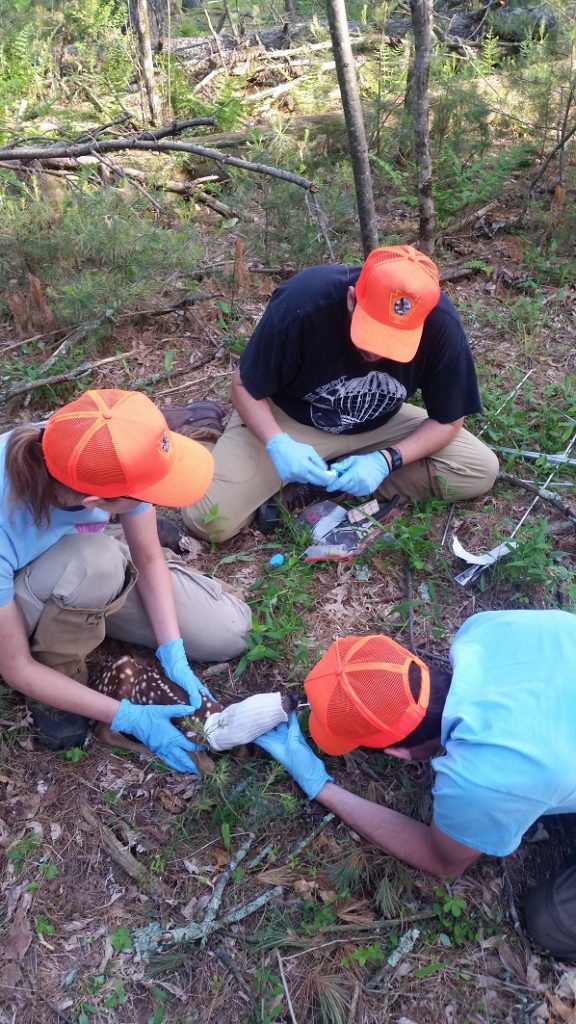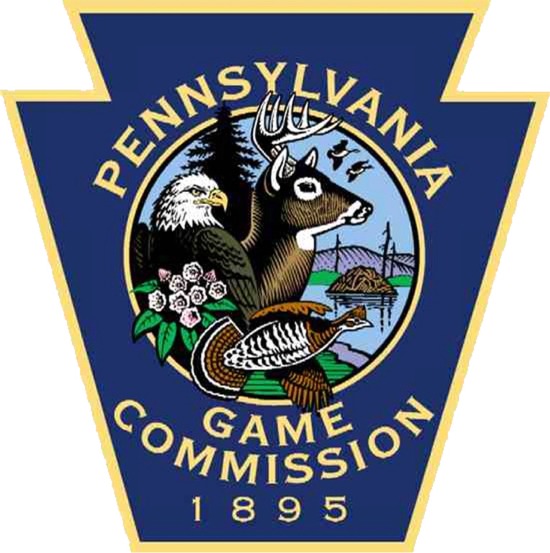From the Northern Crew:
Well, fawn capture season officially started this week! The crew and I headed down to orientation at Penn State on Monday shortly after I had received our first VIT expulsion notification. After a brief orientation, we rushed back to the North to try to find our first fawn of the year. Our friend and Bear Bio-Aide Brandon gave us a hand and we found our first girl of the season around 8pm. Much to our relief she was very considerate by bedding down only a few short feet away from the VIT.
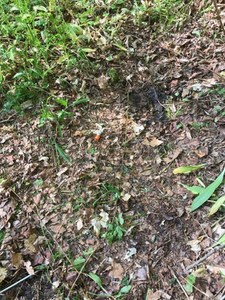 Day two proved successful as well. We received our second VIT notification and located the VIT in record time (at least compared to the night before). Finding the fawn, however, was not quite as easy [the VIT is the bit of orange in the photo].
Day two proved successful as well. We received our second VIT notification and located the VIT in record time (at least compared to the night before). Finding the fawn, however, was not quite as easy [the VIT is the bit of orange in the photo].
After performing grid searches in all directions, going below the hill and performing grid searches toward the direction of the signal the doe was in, and combing the area for over three hours, we had no luck.
The fawn must have taken pity on us because right after we hopped into the trucks and started heading back down the road, she came running out to meet us! I heard a loud bleating, hit the brakes and looked in my rearview mirror. The other crew truck stopped as fast as they could, jumped out, and scooped her up! Later in the week, within very close proximity to where that fawn had come running up the hill to meet us, we found what we presume to be her twin [DNA will tell us for sure]. Our very first potential set of twins.
Fawn searches continued throughout the week. While Jackie, Josh, and I were performing a driving search, we came across a doe and her fawn crossing the road headed up a large (might I add steep hill). The doe quickly bolted up the hill. The fawn considered trying to follow but after a few steps decided otherwise. Jackie nabbed her and we completed our workup.
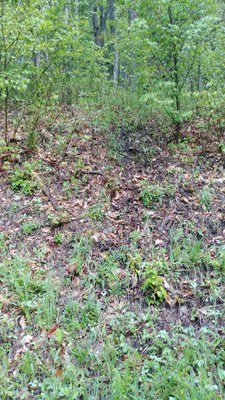 Now here’s where the real fun began. Initially, when we saw the doe and her little girl (another girl!) they were headed up the hill. So, naturally we thought the best thing to do would be to put her back where she was trying to go (the top of the hill). Have any of you ever tried carrying a less-than-enthused neonate up a very steep hill?
Now here’s where the real fun began. Initially, when we saw the doe and her little girl (another girl!) they were headed up the hill. So, naturally we thought the best thing to do would be to put her back where she was trying to go (the top of the hill). Have any of you ever tried carrying a less-than-enthused neonate up a very steep hill?
Keep in mind you can’t use your hands to balance yourself. It was a team effort – me half crawling on my knees carrying her, Jackie up front ready to take the fawn, and Josh in the back prepared to catch me if I slipped and literally pushing my heels up as we ascended Mount Everest! Okay, maybe I’m slightly exaggerating.
Either way, after removing her blindfold the fawn safely reached the top and walked in the right direction (away from us) and back towards where we saw mom watching us during the workup. Since then, her collar’s VHF signal has indicated that she’s still going strong!
We finally found our first bouncing baby boy on Thursday, another successful VIT find. Then on Friday, Alec, Sean and Luke found another fawn while performing a driving search. Clearly, my team is amazing!
We found another VIT fawn fairly close to where we found the VIT itself, approximately 40 yards away. We were surprised she was even that far from the VIT. The terrain was covered in downed logs and very thick thorny vegetation that we thought would have hindered her movement [those little legs are deceiving – they can climb almost anything].
In other news, the team succeeded in “blowing off” (dropping) and recovering a malfunctioning collar of a VIT doe captured this winter. We will continue to monitor her VIT frequency, and as of today, the VIT is sending out a signal indicating it is still inside her.
We had an extremely successful first week and I am excited to see what next week brings. You would never know this was the first week some members of the crew had done radio-tracking. Within just a few days they were biangulating fawn locations and VHF-tracking like pros. Oh, and did I mention how lucky I am to have two previous crew members who are already familiar with the study area and have previous fawn capture experience?
Needless to say I couldn’t be happier with how well the crew worked as a team. This week every single VIT expulsion search was successful and resulted in a collared and ear-tagged fawn. In total, we captured seven fawns in six days – five which are VIT fawns.
PGC Deer and Elk Section
From the Southern Crew:
Hello all,
Our first two VITs were expelled this week!
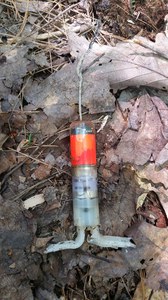 The first VIT notice came around 0230 on Thursday, May 18 in Rothrock. We got out there in the morning and searched the area for six hours. The VIT was buried in a pile of leaves. The antenna and plastic wings were chewed. I assumed the doe (17192) did this while cleaning up the afterbirth.
The first VIT notice came around 0230 on Thursday, May 18 in Rothrock. We got out there in the morning and searched the area for six hours. The VIT was buried in a pile of leaves. The antenna and plastic wings were chewed. I assumed the doe (17192) did this while cleaning up the afterbirth.
We planned to get out the next morning bright and early to locate 17192; however, we received another VIT expulsion email for doe 17193 at 1530. I think we all were surprised that we received an expulsion email, because her collar was malfunctioning and had not connected to satellites at all prior to this. Waiting six hours to allow the doe and fawns bonding time would’ve had us searching around 2130. Since searching in the dark is not ideal and somewhat frowned upon [Yes, it is. Crew safety comes first], we planned to search in the morning. We rode over to doe 17193’s home range and listened to where the doe and the VIT were to prep for the early morning search.
The next morning, 17193 was nowhere to be heard. We hiked into the VIT site and actually located the fawns within a few minutes after reaching the birthing area. A very cute and pleasant surprise for us! We also saw a piece of the placenta laying near a fawn. That was kind of odd since the doe normally cleans up all the afterbirth. 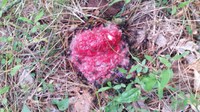
We processed the fawns one at a time obtaining sex, weight, and other physical characteristics as well as recording which biological samples were collected [DNA and saliva samples – more on that soon]. They each received two ear tags each and a radio-collar. We put the fawns right back where we find them. One bedded briefly and ran right underneath a log. As we moved out of the area, she lifted her little head up and her little eyes watched our every move.
Afterwards, we went straight over to re-locate doe 17192 and hopefully a fawn. No luck.
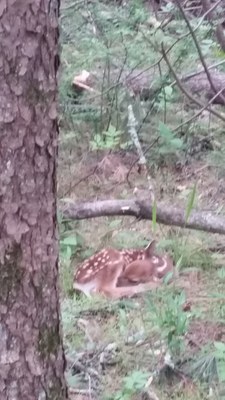 Around 1400, the crew saw a fawn standing next to the road near the Rothrock Study Area. They quickly scooped her up and processed her. Low and behold, fawn #3 for the day!
Around 1400, the crew saw a fawn standing next to the road near the Rothrock Study Area. They quickly scooped her up and processed her. Low and behold, fawn #3 for the day!
Less than half a mile from fawn #3, I found a doe nursing a small fawn that evening. The doe wandered off and the fawn stood briefly and began to wobble away. The crew arrived just as I was getting ready to go scoop her up. Long story short, when we went to look for her she had bed down about 10 meters away – they can disappear in the blink of an eye.
I also saw my first snakes of the year—a Black Rat Snake and an Eastern Garter! Finally!
Next week, the search continues!!
Field Crew Leader
If you would like to receive email alerts of new blog posts, subscribe here.
And Follow us on Twitter @WTDresearch
